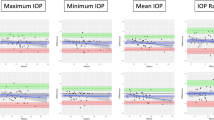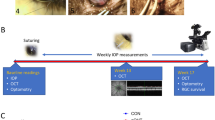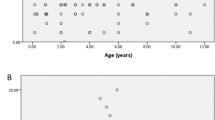Abstract
Aims
To compare supine nighttime intraocular pressure measurements with Perkins applanation tonometry to 24-h sitting intraocular pressures with Goldmann applanation tonometry.
Methods
A prospective, untreated, uncontrolled, observational cohort of qualified consecutive ocular hypertensive or primary open-angle glaucoma patients. Patients underwent sitting intraocular pressure measurements over 24-h by Goldmann and patients had their supine nighttime intraocular pressure measurements by Perkins.
Results
In 100 completed patients, the mean intraocular pressure at 1000, 2200, 0200 and 0600 hours while sitting was 22.5±3.7 mm Hg, and in the supine position, 23.5±4.3 mm Hg (P<0.001). The mean sitting Goldmann intraocular pressures across the three daytime points was 23.3±3.4 mm Hg and across three nighttime points was 21.5±4.0 mm Hg (P<0.001). In contrast, the mean daytime sitting Goldmann intraocular pressure was not different than the mean nighttime supine intraocular pressure evaluated with Perkins (22.8±4.4 mm Hg, P=0.07). However, only 70% of patients were within 1.0 mm Hg of the highest daytime reading for all nighttime supine and sitting intraocular pressures.
Conclusion
This study suggests that with Perkins applanation tonometry the untreated mean supine intraocular pressures are not higher at night than daytime sitting Goldmann applanation tonometry. However, the highest daytime sitting intraocular pressure measurement does not consistently predict the highest nighttime sitting or supine intraocular pressure value.
Similar content being viewed by others
Log in or create a free account to read this content
Gain free access to this article, as well as selected content from this journal and more on nature.com
or
References
Kida T, Liu JH, Weinreb RN . Effect of 24-h corneal biomechanical changes on intraocular pressure measurement. Invest Ophthalmol Vis Sci 2006; 47: 4422–4426.
Liu JH, Kripke DF, Twa MD, Hoffman RE, Mansberger SL, Rex KM et al. Twenty-four-hour pattern of intraocular pressure in the aging population. Invest Ophthalmol Vis Sci 1999; 40: 2912–2917.
Weinreb RN, Liu JH . Nocturnal rhythms of intraocular pressure. Arch Ophthalmol 2006; 124: 269–270.
Quaranta L, Gandolfo F, Turano R, Rovida F, Pizzolante T, Musig A et al. Effects of topical hypotensive drugs on circadian IOP, blood pressure, and calculated diastolic ocular perfusion pressure in patients with glaucoma. Invest Ophthalmol Vis Sci 2006; 47: 2917–2923.
Konstas AG, Nakos E, Tersis I, Lallos NA, Leech JN, Stewart WC . A comparison of once-daily morning vs evening dosing of concomitant latanoprost/timolol. Am J Ophthalmol 2002; 133: 753–757.
García-Feijoo J, Martínez-de-la-Casa JM, Castillo A, Méndez C, Fernández-Vidal A, García-Sánchez J . Circadian IOP-lowering efficacy of travoprost 0.004% ophthalmic solution compared to latanoprost 0.005%. Curr Med Res Opin 2006; 22: 1689–1697.
Konstas AG, Mikropoulos D, Haidich AB, Ntampos KS, Stewart WC . 24-h intraocular pressure control with the travoprost/timolol fixed combination compared with travoprost when both are dosed in the evening in primary open-angle glaucoma. Br J Ophthalmol 2009; 93: 481–485.
Konstas AG, Tsironi S, Vakalis AN, Nasr MB, Stewart JA, Nelson LA et al. Intraocular pressure control over 24 h using travoprost and timolol fixed combination administered in the morning or evening in primary open-angle and exfoliative glaucoma. Acta Ophthalmol Scan 2009; 87: 71–76.
Konstas AG, Mikropoulos D, Kaltsos K, Jenkins JN, Stewart WC . 24-h intraocular pressure control obtained with evening versus morning dosed travoprost in primary open-angle glaucoma. Ophthalmology 2006; 113: 446–450.
Barkana Y, Anis S, Liebmann J, Tello C, Ritch R . Clinical utility of intraocular pressure monitoring outside of normal office hours in patients with glaucoma. Arch Ophthalmol 2006; 124: 793–797.
Orzalesi N, Rossetti L, Bottoli A, Fogagnolo P . Comparison of the effects of latanoprost, travoprost, and bimatoprost on circadian intraocular pressure in patients with glaucoma or ocular hypertension. Ophthalmology 2006; 113: 239–246.
Hughes E, Spry P, Diamond J . 24-h monitoring of intraocular pressure in glaucoma management: a retrospective review. J Glaucoma 2003; 12: 232–236.
Wilensky JT . The role of diurnal pressure measurements in the management of open angle glaucoma. Curr Opin Ophthalmol 2004; 15: 90–92.
Orzalesi N, Rossetti L, Invernizzi T, Bottoli A, Autelitano A . Effect of timolol, latanoprost, and dorzolamide on circadian IOP in glaucoma or ocular hypertension. Invest Ophthalmol Vis Sci 2000; 41: 2566–2573.
Fogagnolo P, Rossetti L, Mazzolani F, Orzalesi N . Circadian variations in central corneal thickness and intraocular pressure in patients with glaucoma. Br J Ophthalmol 2006; 90: 24–28.
Rossetti L, Karabatsas CH, Topouzis F, Vetrugno M, Centofanti M, Boehm A et al. Comparison of the effects of bimatoprost and a fixed combination of latanoprost and timolol on circadian intraocular pressure. Ophthalmology 2007; 114: 2244–2251.
Tajunisah I, Reddy SC, Fathilah J . Diurnal variation of intraocular pressure in suspected glaucoma patients and their outcome. Graefes Arch Clin Exp Ophthalmol 2007; 245: 1851–1857.
Liu JH, Bouligny RP, Kripke DF, Weinreb RN . Nocturnal elevation of intraocular pressure is detectable in the sitting position. Invest Ophthalmol Vis Sci 2003; 44: 4439–4442.
Liu JH, Kripke DF, Weinreb RN . Comparison of the nocturnal effects of once-daily timolol and latanoprost on intraocular pressure. Am J Ophthalmol 2004; 138: 389–395.
Lagerlöf O . Airpuff tonometry versus applanation tonometry. Acta Ophthalmol (Copenh) 1990; 68: 221–224.
Stewart WC . Clinical Practice of Glaucoma. SLACK, Inc.: Thorofare, 1990, pp 255–297.
Ritch R . The Glaucomas. Mosby-Year Book, Inc.: St Louis, 1996, pp 1426–1430.
Stewart WC, Holmes KT, Johnson MA . Washout periods for brimonidine 0.2% and latanoprost 0.005%. Am J Ophthalmol 2001; 131: 798–799.
Stroman GA, Stewart WC, Stewart JA, Deitz TM . Safety of beta-adrenergic blocker washout period in clinical trials. Acta Ophthalmol Scand 1997; 75: 94–95.
Schlecht LP, Brubaker RF . The effects of withdrawal of timolol in chronically treated glaucoma patients. Ophthalmology 1988; 95: 1212–1216.
Baskett JS, Goen TM, Terry JE . A comparison of Perkins and Goldmann applanation tonometry. J Am Optom Assoc 1986; 57: 832–834.
Krieglstein GK, Waller WK . Goldmann applanation versus hand-applanation and schiötz indentation tonometry. Albrecht Von Graefes Arch Klin Exp Ophthalmol 1975; 194: 11–16.
Chiara GF, Semes LP, Potter JW, Cutter GR, Tucker WR . Portable tonometers: a clinical comparison of applanation and indentation devices. J Am Optom Assoc 1989; 60: 105–110.
Wingert TA, Bassi CJ, McAlister WH, Galanis JC . Clinical evaluation of five portable tonometers. J Am Optom Assoc 1995; 66: 670–674.
Wozniak K, Köller AU, Spörl E, Böhm AG, Pillunat LE . Intraocular pressure measurement during the day and night for glaucoma patients and normal controls using Goldmann and Perkins applanation tonometry. Ophthalmologe 2006; 103: 1027–1031.
Duff GR . A double-masked crossover study comparing the effects of carteolol 1 and 2% on intraocular pressure. Acta Ophthalmol (Copenh) 1987; 65: 618–621.
Mundorf TK, Cate EA, Sine CS, Otero DW, Stewart JA, Stewart WC . The safety and efficacy of switching timolol maleate 0.5% solution to timolol hemihydrate 0.5% solution given twice daily. J Ocul Pharmacol Ther 1998; 14: 129–135.
Book SA . Essentials of Statistics. McGraw-Hill, Inc.: New York, 1978, pp 205–215.
Kiuchi T, Motoyama Y, Oshika T . Relationship of progression of visual field damage to postural changes in intraocular pressure in patients with normal-tension glaucoma. Ophthalmology 2006; 113: 2150–2155.
Liu JH, Kripke DF, Hoffman RE, Twa MD, Loving RT, Rex KM et al. Nocturnal elevation of intraocular pressure in young adults. Invest Ophthalmol Vis Sci 1998; 39: 2707–2712.
Stewart WC, Konstas AGP, Nelson LA, Kruft B . Meta-analysis of 24-h intraocular pressure studies evaluating the efficacy of glaucoma medicines. Ophthalmology 2008; 115: 1117–1122.
Stewart WC, Kolker AE, Sharpe ED, Day DG, Konstas AG, Hollo G et al. Long-term progression at individual mean intraocular pressure levels in primary open-angle and exfoliative glaucoma. Eur J Ophthalmol 2008; 18: 765–770.
Ocular Hypertension Treatment Study Group and the European Glaucoma Prevention Study Group. The accuracy and clinical application of predictive models for primary open-angle glaucoma in ocular hypertensive individuals. Ophthalmology 2008; 115: 2030–2036.
Heijl A, Bengtsson B, Chauhan BC, Lieberman MF, Cunliffe I, Hyman L et al. A comparison of visual field progression criteria of 3 major glaucoma trials in early manifest glaucoma trial patients. Ophthalmology 2008; 115: 1557–1565.
Spry PG, Bates AB, Johnson CA, Chauhan BC . Simulation of longitudinal threshold visual field data. Invest Ophthalmol Vis Sci 2000; 41: 2192–2200.
Jonas JB, Budde W, Stroux A, Oberacher-Velten IM, Jünemann A . Single intraocular pressure measurements and diurnal intraocular pressure profiles. Am J Ophthalmol 2005; 139: 1136–1137.
Prata Jr JA, Mérmoud A, LaBree L, Minckler DS . In vitro and in vivo flow characteristics of glaucoma drainage implants. Ophthalmology 1995; 102: 894–904.
Author information
Authors and Affiliations
Corresponding author
Ethics declarations
Competing interests
The authors declare no conflict of interest.
Rights and permissions
About this article
Cite this article
Quaranta, L., Konstas, A., Rossetti, L. et al. Untreated 24-h intraocular pressures measured with Goldmann applanation tonometry vs nighttime supine pressures with Perkins applanation tonometry. Eye 24, 1252–1258 (2010). https://doi.org/10.1038/eye.2009.300
Received:
Revised:
Accepted:
Published:
Issue date:
DOI: https://doi.org/10.1038/eye.2009.300
Keywords
This article is cited by
-
Dorzolamide/Timolol Fixed Combination: Learning from the Past and Looking Toward the Future
Advances in Therapy (2021)
-
Short-term reproducibility of intraocular pressure and ocular perfusion pressure measurements in Chinese volunteers and glaucoma patients
BMC Ophthalmology (2016)
-
Twenty-four-hour intraocular pressure and ocular perfusion pressure characteristics in newly diagnosed patients with normal tension glaucoma
Eye (2016)
-
24-h Efficacy of Glaucoma Treatment Options
Advances in Therapy (2016)
-
Comparison of the effects of bimatoprost and a fixed combination of latanoprost and timolol on 24-hour blood and ocular perfusion pressures: the results of a randomized trial
BMC Ophthalmology (2015)



